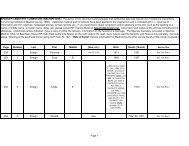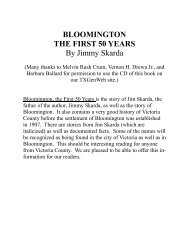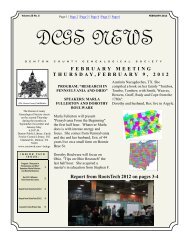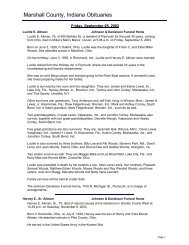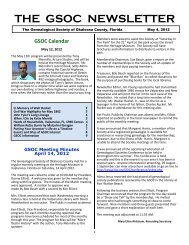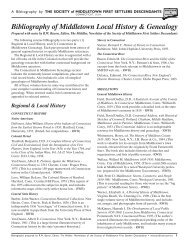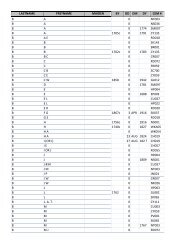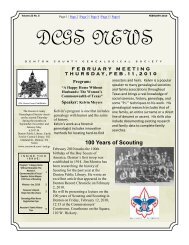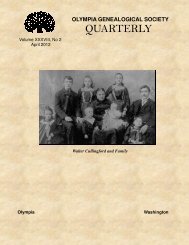Getting to the Roots of Your Family - RootsWeb - Ancestry.com
Getting to the Roots of Your Family - RootsWeb - Ancestry.com
Getting to the Roots of Your Family - RootsWeb - Ancestry.com
Create successful ePaper yourself
Turn your PDF publications into a flip-book with our unique Google optimized e-Paper software.
Early baptismal records <strong>of</strong>ten contain only <strong>the</strong> ordinance date, <strong>the</strong> child’s fa<strong>the</strong>r, <strong>the</strong> godparent(s), and<br />
possibly <strong>the</strong> child’s name. If <strong>the</strong> child’s name is not given in <strong>the</strong> record, it is <strong>of</strong>ten <strong>the</strong> same as <strong>the</strong> name<br />
<strong>of</strong> <strong>the</strong> same-gender godparent. This needs <strong>to</strong> be confirmed by consulting o<strong>the</strong>r records [confirmation,<br />
marriage, burial]. Later records include <strong>the</strong> mo<strong>the</strong>r’s name and <strong>of</strong>ten <strong>the</strong> birth date. If only one date is<br />
given, it is usually <strong>the</strong> christening date. In some areas it is cus<strong>to</strong>mary <strong>to</strong> use <strong>the</strong> same godparents for all<br />
<strong>the</strong> children in a family. This practice can help tie families <strong>to</strong>ge<strong>the</strong>r. House numbers, addresses, and<br />
o<strong>the</strong>r identifiers should always be noted. Illegitimate children are usually clearly marked. Christening<br />
entries may contain marginal notes, such as a cross <strong>to</strong> show <strong>the</strong> child had died. This does not<br />
au<strong>to</strong>matically mean that <strong>the</strong> child died young. Researchers should treat <strong>the</strong>se notations as suggestions<br />
until <strong>the</strong>y are proven. A couple may give <strong>the</strong> same name(s) <strong>to</strong> several children who all lived <strong>to</strong><br />
adulthood, although it is more <strong>com</strong>mon <strong>to</strong> name a younger child after a deceased sibling.<br />
Confirmations<br />
Whenever confirmation records are available, <strong>the</strong>y should be checked. Boys and girls are usually listed<br />
separately. Fa<strong>the</strong>r’s name and/ or birth date and-place may be included. Even if <strong>the</strong>y only list <strong>the</strong><br />
names <strong>of</strong> <strong>the</strong> persons <strong>to</strong> be confirmed, <strong>the</strong>se records document <strong>the</strong> fact that <strong>the</strong> person had survived<br />
childhood.<br />
Marriages<br />
Even early marriage entries <strong>of</strong>ten name <strong>the</strong> bride and groom’s fa<strong>the</strong>rs; mo<strong>the</strong>rs are more <strong>com</strong>monly<br />
included in <strong>the</strong> 19 th Century. Occasionally <strong>the</strong> engagement (Weinkauf) date is included as well. Some<br />
registers also list parish members who had received permission <strong>to</strong> marry in ano<strong>the</strong>r parish (dismissal).<br />
Some registers are arranged alphabetically by last name.<br />
Burials<br />
Burial records vary widely in format and <strong>the</strong> information <strong>the</strong>y contain. Some only list <strong>the</strong> date and <strong>the</strong><br />
decedent’s name; o<strong>the</strong>rs provide a short biography. Present and former spouses may be listed. The<br />
cause <strong>of</strong> death may be included. Living descendants may be listed.<br />
Civil records and duplicates<br />
From 1808 <strong>to</strong> approximately 1812 church <strong>of</strong>ficials also served as registrars for <strong>the</strong> newly created civil<br />
registration <strong>of</strong>fice (Standesamt). This resulted in more detailed records being kept. After 1812 civil<br />
registration was discontinued in many areas <strong>of</strong> Germany, but <strong>the</strong> pas<strong>to</strong>rs were asked <strong>to</strong> submit a yearly<br />
duplicate <strong>of</strong> <strong>the</strong> baptisms, marriages, and deaths for civil purposes, such as draft registration. The<br />
<strong>Family</strong> His<strong>to</strong>ry Library has some <strong>of</strong> <strong>the</strong>se civil duplicates for areas where <strong>the</strong> regular church records<br />
have not yet been filmed, notably for Hannover. These records may be identified as<br />
“Kirchenbuchduplikat”.<br />
Indexes<br />
When searching parish registers, <strong>the</strong> researcher may save time by using indexes, usually found at <strong>the</strong><br />
end <strong>of</strong> each section, when available. Most parish registers do not have indexes, however, and page by<br />
page searching will be necessary. Also, sometimes indexes are in<strong>com</strong>plete, so it may pay <strong>to</strong> check <strong>the</strong><br />
record anyway, even if <strong>the</strong> desired entry was not listed in <strong>the</strong> index.<br />
“Soul registers” and family books<br />
<strong>Family</strong> registers (Familienregister or Familienbücher) were required in Wuerttemberg beginning in<br />
1808, but are occasionally available in o<strong>the</strong>r areas as well. They are a part <strong>of</strong> <strong>the</strong> parish registers and<br />
should be searched whenever found. Included are records <strong>of</strong> <strong>com</strong>plete families, listing parents and<br />
children <strong>to</strong>ge<strong>the</strong>r. This information can be used as a guide in searching <strong>the</strong> baptisms, marriages and<br />
burials, as <strong>the</strong> dates are usually given in <strong>the</strong> family register. However, children who died young may not



